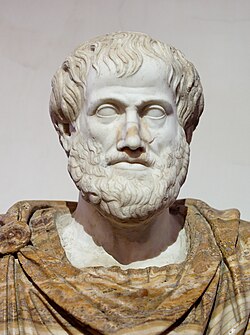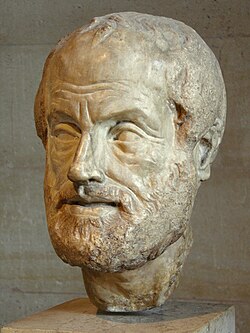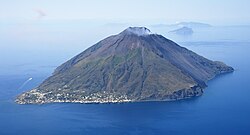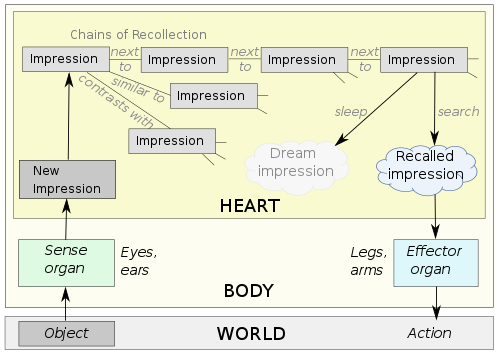Aristoteles
Back

Image source
Wikimedia
https://en.wikipedia.org/wiki/File:Aristotle_Altemps_Inv8575.jpg
Basic data
-
384 BCE in Stagira (Thrakien)
-
†322 BCE in Chalkis auf Euböa
-
Philosoph
-
Athen
Documents
Biographical information from the WeGA
No biographical data found
Biography not available due to one of the following causes:
- Data will be added at a later stage
- Research of the WeGA was without success so far
- It is a well known person where enough information is available online elsewhere, see e.g Wikipedia



![Plato (left) and Aristotle in Raphael's 1509 fresco, The School of Athens. Aristotle holds his Nicomachean Ethics and gestures to the earth, representing his view in immanent realism, whilst Plato gestures to the heavens, indicating his Theory of Forms, and holds his Timaeus.[47][48] (Source: Wikimedia) Plato (left) and Aristotle in Raphael's 1509 fresco, The School of Athens. Aristotle holds his Nicomachean Ethics and gestures to the earth, representing his view in immanent realism, whilst Plato gestures to the heavens, indicating his Theory of Forms, and holds his Timaeus.[47][48] (Source: Wikimedia)](https://upload.wikimedia.org/wikipedia/commons/thumb/9/98/Sanzio_01_Plato_Aristotle.jpg/250px-Sanzio_01_Plato_Aristotle.jpg)



![Aristotle's laws of motion. In Physics he states that objects fall at a speed proportional to their weight and inversely proportional to the density of the fluid they are immersed in.[66] This is a correct approximation for objects in Earth's gravitational field moving in air or water.[68] (Source: Wikimedia) Aristotle's laws of motion. In Physics he states that objects fall at a speed proportional to their weight and inversely proportional to the density of the fluid they are immersed in.[66] This is a correct approximation for objects in Earth's gravitational field moving in air or water.[68] (Source: Wikimedia)](https://upload.wikimedia.org/wikipedia/commons/thumb/c/cd/Aristotle%27s_laws_of_motion.svg/500px-Aristotle%27s_laws_of_motion.svg.png)
![Aristotle argued by analogy with woodwork that a thing takes its form from four causes: in the case of a table, the wood used (material cause), its design (formal cause), the tools and techniques used (efficient cause), and its decorative or practical purpose (final cause).[70] (Source: Wikimedia) Aristotle argued by analogy with woodwork that a thing takes its form from four causes: in the case of a table, the wood used (material cause), its design (formal cause), the tools and techniques used (efficient cause), and its decorative or practical purpose (final cause).[70] (Source: Wikimedia)](https://upload.wikimedia.org/wikipedia/commons/thumb/7/77/Aristotle%27s_Four_Causes_of_a_Table.svg/500px-Aristotle%27s_Four_Causes_of_a_Table.svg.png)



![Aristotle recorded that the embryo (fetus pictured) of a dogfish was attached by a cord to a kind of placenta (the yolk sac), like a higher animal; this formed an exception to the linear scale from highest to lowest.[107] (Source: Wikimedia) Aristotle recorded that the embryo (fetus pictured) of a dogfish was attached by a cord to a kind of placenta (the yolk sac), like a higher animal; this formed an exception to the linear scale from highest to lowest.[107] (Source: Wikimedia)](https://upload.wikimedia.org/wikipedia/commons/thumb/0/00/FMIB_46109_Foetal_Picked_Dogfish%2C_with_the_ovum_attached_%28no_label%29.jpeg/250px-FMIB_46109_Foetal_Picked_Dogfish%2C_with_the_ovum_attached_%28no_label%29.jpeg)



![The Blind Oedipus Commending his Children to the Gods (1784) by Bénigne Gagneraux. In his Poetics, Aristotle uses the tragedy Oedipus Tyrannus by Sophocles as an example of how the perfect tragedy should be structured, with a generally good protagonist who starts the play prosperous, but loses everything through some hamartia (fault).[157] (Source: Wikimedia) The Blind Oedipus Commending his Children to the Gods (1784) by Bénigne Gagneraux. In his Poetics, Aristotle uses the tragedy Oedipus Tyrannus by Sophocles as an example of how the perfect tragedy should be structured, with a generally good protagonist who starts the play prosperous, but loses everything through some hamartia (fault).[157] (Source: Wikimedia)](https://upload.wikimedia.org/wikipedia/commons/thumb/8/82/B%C3%A9nigne_Gagneraux%2C_The_Blind_Oedipus_Commending_his_Children_to_the_Gods.jpg/500px-B%C3%A9nigne_Gagneraux%2C_The_Blind_Oedipus_Commending_his_Children_to_the_Gods.jpg)


![Islamic portrayal of Aristotle (right) in the Kitāb naʿt al-ḥayawān, c. 1220.[191] (Source: Wikimedia) Islamic portrayal of Aristotle (right) in the Kitāb naʿt al-ḥayawān, c. 1220.[191] (Source: Wikimedia)](https://upload.wikimedia.org/wikipedia/commons/thumb/0/02/Ibn_Bakht%C4%ABsh%C5%AB%CA%BF%2C_Kit%C4%81b_na%CA%BFt_al-%E1%B8%A5ayaw%C4%81n_probably_Baghdad%2C_c._1225._London%2C_British_Library%2C_Or._2784%2C_A_student_sitting_with_Aristotle_%28right%29.jpg/250px-Ibn_Bakht%C4%ABsh%C5%AB%CA%BF%2C_Kit%C4%81b_na%CA%BFt_al-%E1%B8%A5ayaw%C4%81n_probably_Baghdad%2C_c._1225._London%2C_British_Library%2C_Or._2784%2C_A_student_sitting_with_Aristotle_%28right%29.jpg)







